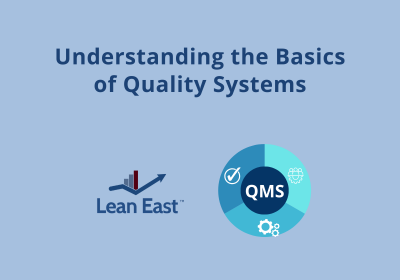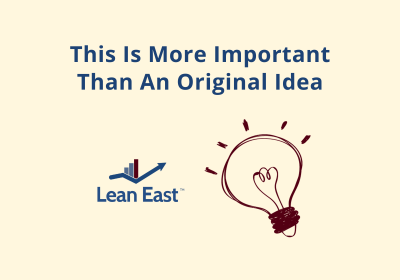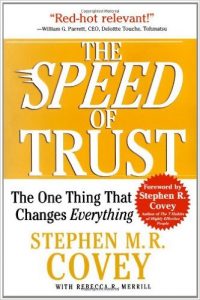 The Speed of Trust: The One Thing That Changes Everything is a book by Stephen M. R. Covey . . . but not the well-known author of The Seven Habits of Highly Effective People who died after a biking accident in 2012, rather his oldest son. The Speed of Trust is now ten years old and I have referred to the book numerous times while training and coaching leaders. I wanted to cover the key topics of the book in a post, but a complete summary already exist out on the web at this link so there is no need to repeat. Instead, I will briefly discuss trust accounts and the four cores of trust- topics I share in my coaching work the most.
The Speed of Trust: The One Thing That Changes Everything is a book by Stephen M. R. Covey . . . but not the well-known author of The Seven Habits of Highly Effective People who died after a biking accident in 2012, rather his oldest son. The Speed of Trust is now ten years old and I have referred to the book numerous times while training and coaching leaders. I wanted to cover the key topics of the book in a post, but a complete summary already exist out on the web at this link so there is no need to repeat. Instead, I will briefly discuss trust accounts and the four cores of trust- topics I share in my coaching work the most.
The Late Steven R. Covey
The late Stephen R. Covey taught a great lesson about trust when he explained how emotional bank accounts work. We each have balances we informally keep with family, friends, associates, coworkers, and anyone else we interact with.
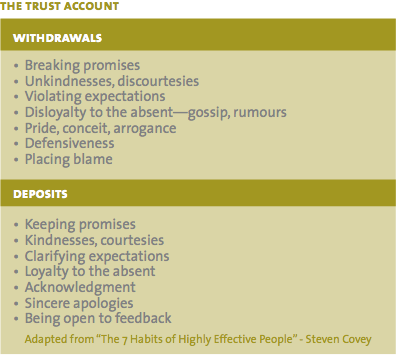
Emotional bank accounts have deposits and withdrawals just like a regular bank account. Positive interactions are deposits and negative interactions are withdrawals. I typically assign people I meet on the street a positive initial balance, but the telemarketer who just called is probably starting with a negative balance due to my personal stereotype about this profession. We all do this, with different biases and initial balances based on our own experiences.
We make deposits and withdrawals with every personal and professional interaction – see the examples to the right. Are you making trust deposits in your daily interactions with your spouse? How about your kids, co-workers, and employees?
Steven M. R. Covey
Stephen M. R. Covey wrote The Speed of Trust after realizing the multiplying effect trust has in business and life. He points out that much of the dysfunction and unhappiness we experience in the workplace is due to low trust, but the organizations and cultures with alignment, effortless communication and high collaboration experience loyalty and trust. Most importantly, Covey shares that you can improve trust – in an organization or a relationship – by focusing on the 4 cores of credibility: integrity, intent, capabilities and results.
The 4 Cores of Credibility
Credibility can be determined based on two primary questions:
- Do I trust myself?
- Can others trust me?
Covey shares 4 keys to credibility and building trust. Intent and integrity are both character cores. Capabilities and results are competence cores. You need all four cores in order to have credibility and grow trust.
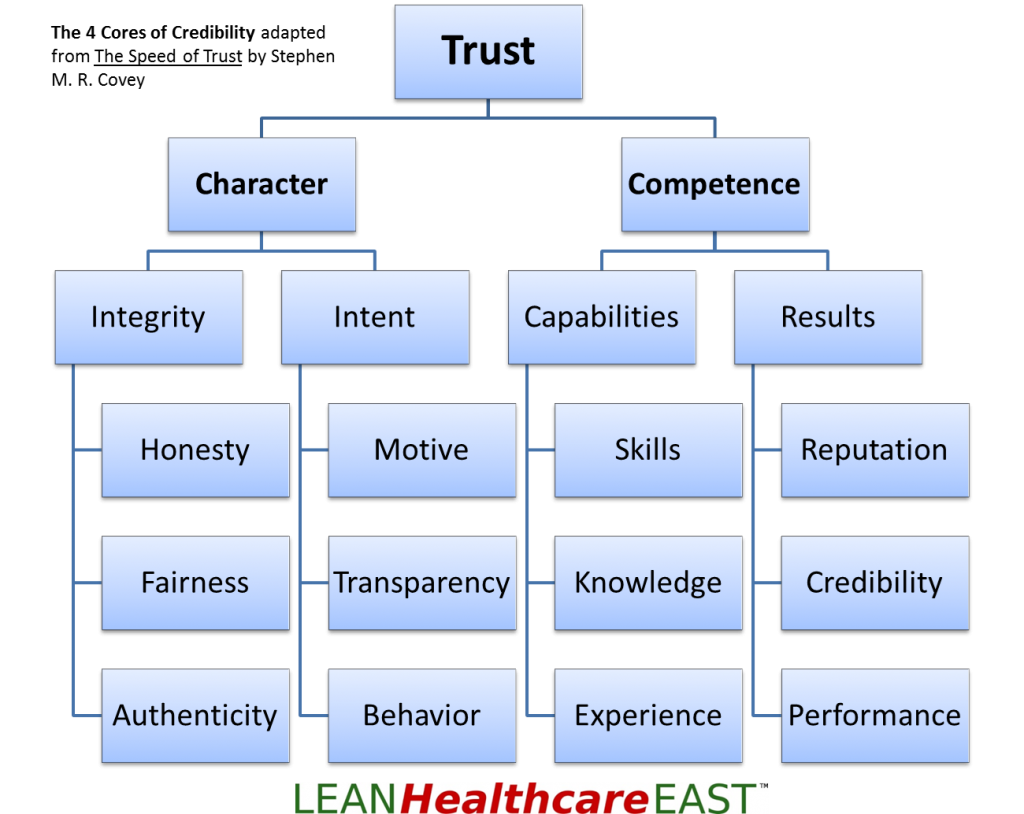
Integrity: Are you honest, congruent and humble?
The first character core is integrity, which is more than honesty (telling the truth); it is also leaving the right impression. There are three qualities: congruence, humility and courage.
Think of congruence as having no gap between intent and behavior; it is walking the talk. Humility is putting what is right ahead of being right. It means standing up for what you believe even when that is hard. Humble people recognize that they stand on the shoulders of those who have gone before. The opposite of humility is arrogance and pride. Integrity also requires the courage to do the right thing, even when that is hard. It is doing what you know is right regardless of the consequences.
There are three ways to increase your integrity:
- Make and keep commitments to yourself: Be honest with yourself first! Treat internal commitments like you would a promise to another. It helps when you aren’t impulsive with these promises and don’t make too many commitments in the first place.
- Stand for something: Do what is right. This means never having to wrestle with your conscience.
- Be open: Humility includes always seeking to learn and grow. Close mindedness is sign of arrogance; do you honestly believe you have the world figured out? Or is there more you can learn?
Intent: What’s Your Agenda?
Intent is a character core, defined as our “plan” or “purpose” and part of our value system. Covey breaks intent down to three things.
Our motive is why we do what we do. The greatest motive in building trust is genuinely caring. If you don’t care about a cause, that is okay, but be prepared to deal with the repercussions. If you want to care, start to do caring things. Feelings often will follow actions. The worst is when you “pretend” to care; that means you don’t have intent or integrity. It is better to be transparent about how you feel.
Agenda stems from our motive. The best agenda is honestly seeking mutual benefit, win-win for both parties. A key here is to be open and upfront, avoiding hidden agendas. Behavior is “where the rubber meets the road.” Behavior is what people see and judge; it is the difference between telling someone you love them and showing them you love them.
“You can behave yourself out of a problem you’ve behaved yourself into . . . and often faster than you think!” – Stephen M. R. Covey
Covey explains three ways to improve intent. Examine and refine your motives, declare your intent and choose abundance.
Capabilities: Do you know what you are talking about?
This is a competence core; having high integrity and the right intent doesn’t matter if you don’t have the technical abilities for the task at hand. To help think about the various dimensions of capabilities, Covey uses the acronym TASKS: Talents, Attitude, Skills, Knowledge, and Style.
- Talents are the things we naturally do well and love to do. These are our natural strengths.
- Attitude is how you see things. How do you choose to look at a situation?
- Skills are what we have learned to do well. Continuous improvement is necessary for increasing skills.
- Knowledge is what you know and continue to learn. Can your knowledge on the matter be trusted?
- Style is your unique way – your personality. Are you loud, brash, quiet, reserved, a good dresser, articulate, etc.? What is the way you go about doing things?
To increase your capabilities, follow your strengths and your passions, remain relevant by continually increasing your knowledge and improving your skills and know where you are going.
People follow leaders who know where they are going.
Results: What is your track record?
The final competency core is about delivering results. Results matter! People don’t trust people who don’t deliver results. In The Speed of Trust Covey writes, “… if the results aren’t there, neither is the credibility. Neither is the trust. It’s just that simple; it’s just that harsh.”
Both what you accomplish and how you accomplish it matters. I like to use a balanced scorecard approach to results. Development and readiness for the future matters as much as bottom line results today. People will judge your credibility on your past results (what you have proven you can do), your current results (what you are contributing right now) and also your potential results (what people anticipate you will accomplish in the future).
To improve in this area first take responsibility for results, not activity. Expect to achieve your goals. Having a successful mindset will translate into positive results so, whenever possible, finish strong. When the going gets tough, the tough get going.
In conclusion, we hope learning about the 4 cores is helpful to you and your team. Trust is critical to relationships and if you have a high score on all 4 cores – integrity, intent, capabilities and results – you are much more likely to benefit from a trust multiplier. If you lack any of the cores expect to pay a trust penalty.
The team at Lean East trusts that you will benefit from reading this summary. The remainder of the book is also worth reading, especially the 13 behaviors common to high-trust leaders.

